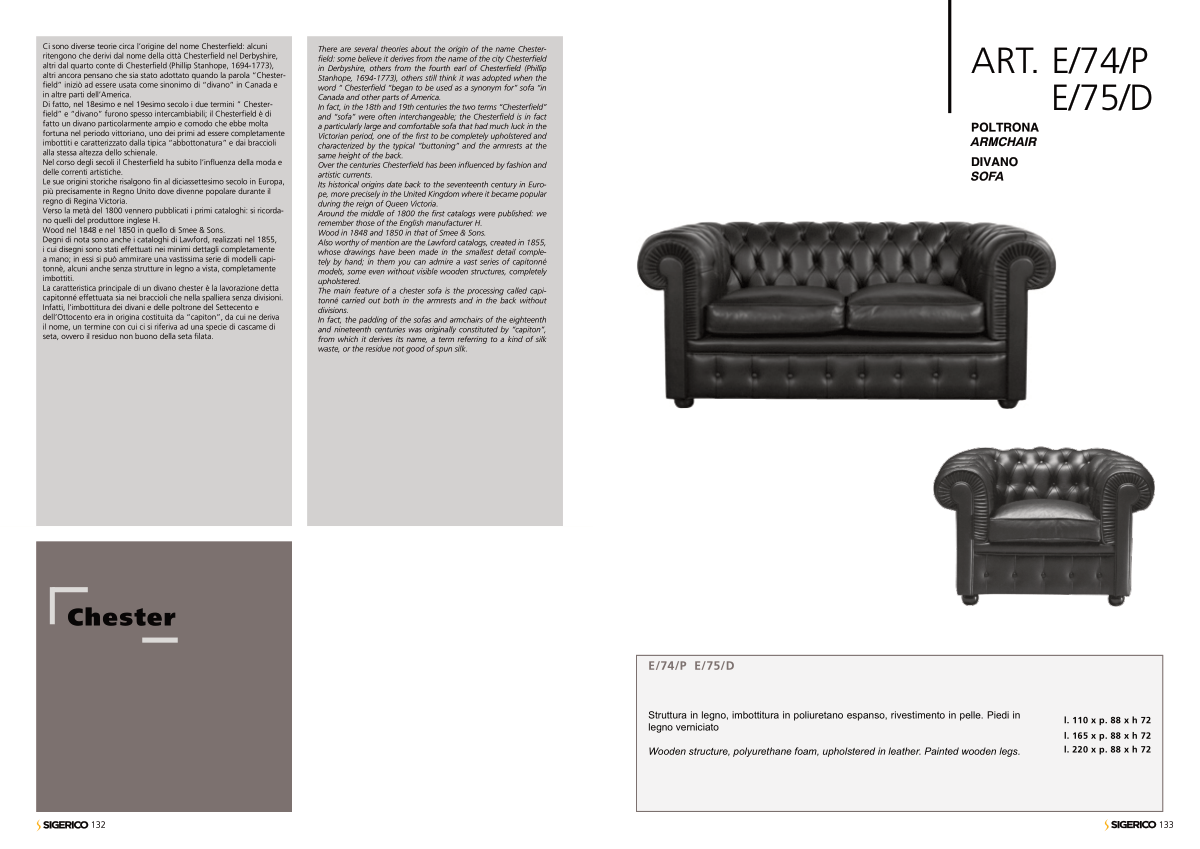Chester
Ci sono diverse teorie circa l’origine del nome Chesterfield: alcuni
ritengono che derivi dal nome della città Chesterfield nel Derbyshire,
altri dal quarto conte di Chesterfield (Phillip Stanhope, 1694-1773),
altri ancora pensano che sia stato adottato quando la parola “Chester-
field” iniziò ad essere usata come sinonimo di “divano” in Canada e
in altre parti dell’America.
Di fatto, nel 18esimo e nel 19esimo secolo i due termini ” Chester-
field” e “divano” furono spesso intercambiabili; il Chesterfield è di
fatto un divano particolarmente ampio e comodo che ebbe molta
fortuna nel periodo vittoriano, uno dei primi ad essere completamente
imbottiti e caratterizzato dalla tipica “abbottonatura” e dai braccioli
alla stessa altezza dello schienale.
Nel corso degli secoli il Chesterfield ha subito l’influenza della moda e
delle correnti artistiche.
Le sue origini storiche risalgono fin al diciassettesimo secolo in Europa,
più precisamente in Regno Unito dove divenne popolare durante il
regno di Regina Victoria.
Verso la metà del 1800 vennero pubblicati i primi cataloghi: si ricorda-
no quelli del produttore inglese H.
Wood nel 1848 e nel 1850 in quello di Smee & Sons.
Degni di nota sono anche i cataloghi di Lawford, realizzati nel 1855,
i cui disegni sono stati effettuati nei minimi dettagli completamente
a mano; in essi si può ammirare una vastissima serie di modelli capi-
tonnè, alcuni anche senza strutture in legno a vista, completamente
imbottiti.
La caratteristica principale di un divano chester è la lavorazione detta
capitonné effettuata sia nei braccioli che nella spalliera senza divisioni.
Infatti, l’imbottitura dei divani e delle poltrone del Settecento e
dell’Ottocento era in origina costituita da “capiton”, da cui ne deriva
il nome, un termine con cui ci si riferiva ad una specie di cascame di
seta, ovvero il residuo non buono della seta filata.
There are several theories about the origin of the name Chester-
field: some believe it derives from the name of the city Chesterfield
in Derbyshire, others from the fourth earl of Chesterfield (Phillip
Stanhope, 1694-1773), others still think it was adopted when the
word “ Chesterfield “began to be used as a synonym for” sofa “in
Canada and other parts of America.
In fact, in the 18th and 19th centuries the two terms “Chesterfield”
and “sofa” were often interchangeable; the Chesterfield is in fact
a particularly large and comfortable sofa that had much luck in the
Victorian period, one of the first to be completely upholstered and
characterized by the typical “buttoning” and the armrests at the
same height of the back.
Over the centuries Chesterfield has been influenced by fashion and
artistic currents.
Its historical origins date back to the seventeenth century in Euro-
pe, more precisely in the United Kingdom where it became popular
during the reign of Queen Victoria.
Around the middle of 1800 the first catalogs were published: we
remember those of the English manufacturer H.
Wood in 1848 and 1850 in that of Smee & Sons.
Also worthy of mention are the Lawford catalogs, created in 1855,
whose drawings have been made in the smallest detail comple-
tely by hand; in them you can admire a vast series of capitonné
models, some even without visible wooden structures, completely
upholstered.
The main feature of a chester sofa is the processing called capi-
tonné carried out both in the armrests and in the back without
divisions.
In fact, the padding of the sofas and armchairs of the eighteenth
and nineteenth centuries was originally constituted by “capiton”,
from which it derives its name, a term referring to a kind of silk
waste, or the residue not good of spun silk.
l. 110 x p. 88 x h 72
l. 165 x p. 88 x h 72
l. 220 x p. 88 x h 72
Struttura in legno, imbottitura in poliuretano espanso, rivestimento in pelle. Piedi in
legno verniciato
Wooden structure, polyurethane foam, upholstered in leather. Painted wooden legs.
ART. E/74/P
E/75/D
POLTRONA
ARMCHAIR
DIVANO
SOFA
133
132
E/74/P E/75/D


